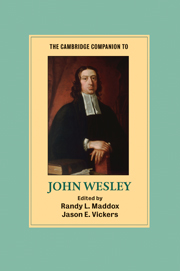Book contents
- Frontmatter
- Introduction
- Part I Wesley’s context
- Part II Wesley’s life
- Part III Wesley’s work
- Part IV Wesley’s legacy
- 14 Spread of Wesleyan Methodism
- 15 The holiness/pentecostal/charismatic extension of the Wesleyan tradition
- 16 The African American wing of the Wesleyan tradition
- 17 Current debates over Wesley’s legacy among his progeny
- Select bibliography
- Index
16 - The African American wing of the Wesleyan tradition
from Part IV - Wesley’s legacy
Published online by Cambridge University Press: 28 September 2010
- Frontmatter
- Introduction
- Part I Wesley’s context
- Part II Wesley’s life
- Part III Wesley’s work
- Part IV Wesley’s legacy
- 14 Spread of Wesleyan Methodism
- 15 The holiness/pentecostal/charismatic extension of the Wesleyan tradition
- 16 The African American wing of the Wesleyan tradition
- 17 Current debates over Wesley’s legacy among his progeny
- Select bibliography
- Index
Summary
Blacks embraced Methodism when the first Wesleyan preachers arrived, in 1766, from England to colonial America. The conversion of Betty, a slave in New York City, that same year demonstrates that blacks were among the first Americans to affiliate with the Methodist movement. Moreover, Captain Thomas Webb initiated revivals in Brooklyn in 1766 that laid foundations for a biracial congregation that eventually emerged as the African Wesleyan Methodist Episcopal Church. Through developments like this, African Americans quickly moved beyond being introduced to Methodism by third parties. They were exposed to Wesleyan hymnody, sermons, doctrine, and discipline first hand in innumerable camp meetings, revivals, and chapel services. As early Methodist members, blacks drew emancipationist themes from Wesleyan beliefs and embedded black spirituality in Wesleyan worship and devotional practices. These interpretations, blacks believed, showed that their understanding of Methodism was the linear embodiment of what John Wesley intended for his religious movement. Piety, deep and expressive spirituality, and social holiness became for African Americans the distinctive marks of Methodism and a basis to judge the authenticity of Methodist professions and practices from both white institutions and white individuals.
- Type
- Chapter
- Information
- The Cambridge Companion to John Wesley , pp. 282 - 297Publisher: Cambridge University PressPrint publication year: 2009



